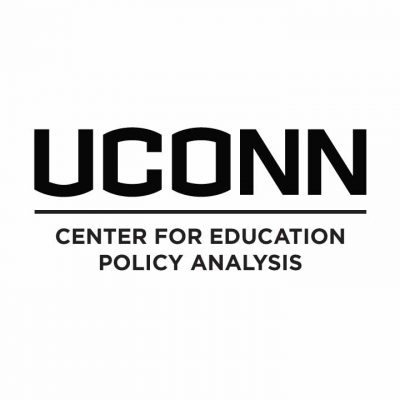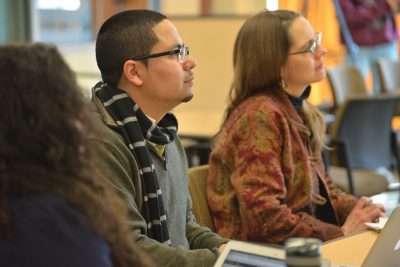
Editor’s Note: Alexandra J. Lamb, a doctoral candidate in the Learning, Leadership, and Education Policy program at the Neag School, prepared the following issue brief — in affiliation with the Center for Education Policy Analysis (CEPA) — about school districts that are introducing technology into classrooms through what are known as 1:1 programs.
School districts across the nation are spending significant resources to introduce technology into classrooms, up to $19 billion nationwide in 2018.i Many districts use technology to individualize learning, increase student engagement, and improve equity.ii One popular way of implementing technology initiatives in schools is through 1:1 programs (pronounced “one to one”). These programs provide one device per student,iii most frequently a tablet or Google Chromebook.
How can school districts foster an environment that enables 1:1 technology programs to enhance learning?
In Connecticut, some districts have implemented 1:1 technology programs as a response to the Connecticut State Educational Technology Goals and Plan.iv For example, Glastonbury implemented a 1:1 iPad program in grades 7-12 as a way of shifting instructional practices to focus on 21st century skills.v Both Manchestervi and Suffieldvii implemented 1:1 Chromebook programs in their middle and high schools to support student collaboration and creativity. The plan highlights 2018 as a year to focus on equity and educational technology standards and best practices.
Some districts have answered this call through 1:1 programs and more districts are sure to follow. With more affordable technology, more peer schools to reference, more research to support the positive effects of 1:1 programs, and increasing use of technology for students outside of school, we will continue to see schools and districts choosing 1:1 programs as a means of integrating technology into teaching and learning. These programs will undoubtedly require significant resources, and thus it is important to understand the value of 1:1 technology programs and the most effective ways to implement them. The purpose of this brief is to present current research on 1:1 technology programs, their impact, and characteristics of districts that successfully implement technology programs. Finally, the brief offers recommendations for districts to build or improve 1:1 technology programs.
What can 1:1 programs provide?
Several research studies have found that 1:1 programs enhance student achievement in writing, problem solving,viii reading,ix and math.x Others have found that 1:1 programs decrease achievement gaps between socioeconomic groups and students with varied learning abilities,xi and shift the ways that students learn by increasing student engagement with course content and learning assessments.xii Students involved in technology programs also develop information literacy and digital communication skills.xiii There are positive impacts on teaching practices as well. Studies show that teachers shift from whole class teaching to more individualized instructionxiv and student-centered learning.xv
What are the concerns?
Conversely, some researchers have found that some 1:1 programs do not impact student achievement.xvi Other researchers highlight positive gains in science but find no gains in math.xvii There are also concerns about student engagement. One study found that student engagement spikes during the initial implementation of a 1:1 program but can be hard to sustain.xviii Additionally, students and teachers acknowledge technological devices can sometimes distract students,xix further highlighting the complexity of using technology in school settings.
How can district implement 1:1 programs successfully?
 Considering the potential benefits of 1:1 technology programs and the concerns, how can districts foster an environment that enables 1:1 technology programs to enhance learning? District leaders can take several steps to help schools implement 1:1 technology programs. Leaders can address: infrastructure, curricular integration, leadership, cultural supports, and professional development.
Considering the potential benefits of 1:1 technology programs and the concerns, how can districts foster an environment that enables 1:1 technology programs to enhance learning? District leaders can take several steps to help schools implement 1:1 technology programs. Leaders can address: infrastructure, curricular integration, leadership, cultural supports, and professional development.
Infrastructure
Implementing a successful 1:1 program depends on building infrastructure to support fully integrated technology. Research often points to a lack of infrastructure and resources as a reason that teachers struggle to implement 1:1 programs.xx Two important elements of infrastructure are connectivity and access. To successfully implement a 1:1 program, many schools may need to upgrade their wireless networks to allow all students and teachers to access the internet simultaneously.xxi
This becomes especially important when administering digital standardized tests. Infrastructure also includes increasing the size and scope of technology support programs.xxii Staff are needed to fix broken equipment and intervene in classrooms when technology is not working, as well as work with teachers to design curriculum and teach students directly. Some schools separate these roles and others combine them; it is most important that schools address both maintenance and curricular integration. Repairing equipment and preparing devices for rollout also takes physical space. Careful examination of teacher and student needs can help school and district leaders decide the best way to design technology-related positions and spaces to provide consistent, diverse, and accessible support.
Curriculum Integration
Another area to address is meaningful curricular integration as prescribed by the technological, pedagogical, and content knowledge (TPACK) framework.xxiii This framework describes the way the three spheres of technological, pedagogical, and content knowledge overlap to form new knowledge and new uses of that knowledge. Researchers have expanded on the TPACK framework to offer the important distinction between technological integration vs curricular integration.xxiv Technological integration frames the skills needed as separate from the curriculum, suggesting that teachers add them to existing teaching and learning approaches in the classroom. Curricular integration frames technological skill as a vital and integral piece of the curriculum and pushes teachers to reexamine pedagogical practices.xxvAdding support staff that are experienced in curricular integration will help to support teachers in making changes to their practice. District leaders can use these frameworks to support important shifts in beliefs, pedagogy, and student-teacher relationshipsxxvi to create strong 1:1 technology programs.
Providing opportunities for continued learning is an integral part of preparing teachers and leaders to begin, and perhaps more importantly, continue the work of change through technology.
Leadership
Another area to address is school and district leadership, which researchers have pointed out may be the hinge on which successful technology implementation sits. Leaders play an important role in fostering shifts in teachers’ beliefs and behaviors around authority, decision making, and school culture. Both teachers and leaders need to have a strong understanding of how the technology being implemented works and the ways in which these technological tools change relationships between teaching and learning.xxvii Embracing and understanding the changes that technology programs, specifically 1:1 programs, may engender, is integral in fostering success. One change may include shifting traditional roles for leaders, teachers, and staff to better position them to create change.xxviii Creating distributed leadership structures in which different stakeholders can lead, make decisions, and set an example may allow for stronger participation and implementation across schools and districts. Another change may be in fostering more collaborative teams that can address problems as they arise by sharing diverse learning and experiences and consequently these teams can create new knowledge. xxix These changes happen at both the individual and organizational levelxxx and thus need the support of all stakeholders to happen successfully, starting with building leaders.

Building culture
At the district level, it is especially important for superintendents to be collaborative, set clear expectations, and model and support risk-taking.xxxi This may come in the form of clearly framed policies and goals that are created by inclusive and diverse teams, or by creating workshop spaces for teachers to try new ideas in supportive environments. Especially in districts that are under strong accountability pressures,xxxii it is vital to create spaces in which teachers and technology integrators can collaborate and take risks without retribution.xxxiiiAllowing time for teachers to observe, learn from, and support each other through both failure and success is important.xxxiv Additionally, a strong vision for the purpose and use of technology in schools is the foundation for a culture that supports technology use and is vital in achieving successful technology integration.xxxv In building and communicating this vision, inclusion of diverse stakeholders in making district policies, clear communication of those policies, as well as school level support for those policies are important to the successful implementation of 1:1 technology initiatives.xxxvi
Professional Development
Another key area to address is professional development. Providing opportunities for continued learning is an integral part of preparing teachers and leaders to begin, and perhaps more importantly, continue the work of change through technology.xxxvii A teacher’s understanding of and comfort level with technology is foundational to successful classroom use of technology.xxxviii Thus, creating professional development that increases both comfort and knowledge is an important first step in a successful 1:1 program. However, as previously discussed, expanding professional development to address successful curricular integration and the overlapping spheres of technological, pedagogical, and content knowledge is a vital second step. This support also needs to be differentiated to meet different needs and should be easily accessible for all teachers.xxxix Supporting teachers in making changes to their classroom practices may lie in district-supported professional development that is meaningful and recurrent.
In all of these ways, leaders, both at the district and school levels, can develop and promote an environment that allows for change through the adoption of a 1:1 technology initiative, fulfilling the promises of these programs.
Recommendations
Technology cannot change schools on its own. Rather, technology initiatives require the careful planning of schools and districts to foster and accommodate change.xl The research discussed in this brief highlights the ways superintendents and other district and building leaders can create organizations that support 1:1 technology initiatives. To begin, leaders must assess whether districts have the structures and supports in place to create meaningful change and address those gaps before introducing a new tool. These structures and supports should include:
- Infrastructure prepared to handle increased technology use by teachers and students
- Regular, quality professional development that addresses both teachers’ technological skill and curricular integration
- District and school culture that embraces collaboration and risk
- Strong district-level vision for the purpose and use of technology
- Diverse teams to make decisions, address problems, and make policy
These supports can create districts prepared to implement successful 1:1 technology programs that can improve teaching and learning.
CEPARE is a research center based at the Neag School that seeks to inform educational leaders and policymakers on issues related to the development, implementation, and consequences of education policies. Learn more about CEPA at cepare.uconn.edu. Access the original PDF of “Assessing the Capacity for Change: Preparing a District for a 1:1 Technology Initiative” (including all references), as well as other CEPARE presentations and publications, here.
Related Stories:
 Facebook
Facebook
 Twitter
Twitter
 LinkedIn
LinkedIn
